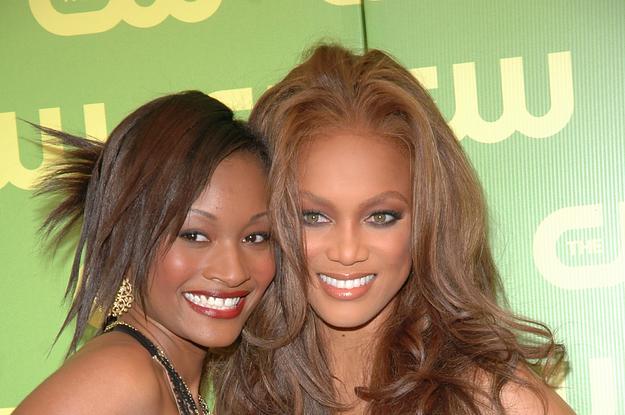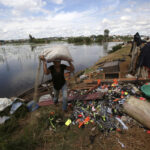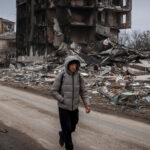
America’s Next Top Model is no longer in vogue. Over the last few years, the show has received a crush of bad press. The series, which aired from 2003 to 2018, sought to pluck an ordinary woman from obscurity and turn her into a glamazon, but behind the scenes, two new reports show, the producers put ratings ahead of almost anything else. Today Business Insider released a story about the various indignities contestants faced on the show, including producers who would bring up contestants’ past traumas in order to play on their emotions, as well as purposefully create unsafe work environments for increased drama. And in late March, Bustle published an illuminating story about Angelea Preston, a former America’s Next Top Model winner who was unceremoniously stripped of her title due to “unusual circumstances,” as series creator Tyra Banks put it at the time.
Preston first appeared as a contestant in 2009, then again in 2010, and finally as an All-Star in 2011. Though she didn’t make the semifinal round during her first appearance, her determination (she slept in a bus terminal in order to make tryouts for the show) and candor regarding the death of her infant daughter endeared her to fans; she was brought on for Cycle 12 (ANTM referred to its various seasons as “cycles”) in 2010, when she narrowly missed being on the finale.
Once the show was over, Preston went to New York City — but the high fashion opportunities she thought she would receive never became a reality. She eventually ended up dating someone who encouraged her to sleep with men for money and who, she said, physically abused her.
Friends of Preston’s, including Krista White, who won Cycle 14 of America’s Next Top Model, said they reached out to producers and anyone associated with the show who might be able to help her friend, including Banks. But, as far as White knows, no one from the show assisted Preston.
Then in 2011, ANTM invited Preston to compete in the All-Stars season. And although she went on to win, the public would never witness her triumphant comeback. Tyra announced during the finale that Preston had been disqualified for “unusual circumstances.” In 2014, the Los Angeles Times reported that Preston had sued Banks after the former contestant said she had informed producers about her stint as a sex worker and then lost her title as a result. The Bustle story appears to confirm that once producers learned of Preston’s background, they disqualified her. As social mores around sex work change, the producers’ decision seems especially baffling. (Ken Mok, a longtime producer of the show and friend of Banks’s, offered a statement to Bustle: “There’s really nothing I can add to Angelea’s story as this happened 10 years ago and it has already been reported on extensively. On a personal note, I thought Angelea was a wonderful addition to ANTM. She was talented and charismatic. … I wish her nothing but the best in her future.”)
Preston’s story is only the latest example of alarming behavior allegedly doled out by the producers of Top Model. In 2003, Top Model was actually kind of progressive; its first cycle featured an out and proud Black lesbian woman, a staunch atheist, and a plus-size model who competed against her thinner counterparts. “I think you are the problem of why women are leaning over their toilets at this very moment and vomiting after they’ve eaten or taken laxatives,” Banks told judges Janice Dickinson and Steve Santagati in the first season, who were criticizing a plus-size contestant about her weight and downplaying her chances of succeeding in the modeling industry.
Cycle 11 in 2008 featured a trans woman named Isis King, who first made an impression on Banks after working as a background model for a shoot during the show’s 10th cycle. Banks even later helped pay for King’s sex reassignment surgery. Back then, it seemed like Banks was ostensibly committed to broadening people’s concepts of beauty. But in recent years, the show’s legacy has been called into question, with fans and critics reflecting on its toxicity and the ways Banks and fellow judges gave conflicting advice to models as the seasons progressed, pushing contestants to make decisions that went against their values. The show increasingly became more interested in garnering high ratings, with its ever-changing themes, than in creating successful, working models.
Top Model first reentered the zeitgeist when the series became widely available to stream on various platforms. “Tyra Banks is a domestic terrorist. She was shaving bitches BALD and sending them home the next day,” read one tweet from 2018, a reference to the infamous makeover episodes Top Model would do every season. The aspiring supermodels were given heightened looks that took them from drab to fab, though there were plenty of moments when contestants would push back on the makeovers Banks wanted them to rock. But then in the summer of 2020, a clip from the show’s sixth cycle featuring contestant Dani Evans went viral. In the clip, the judges castigate Evans for refusing to have her tooth gap closed. “Do you really think you can have a CoverGirl contract with a gap in your mouth?” Banks asks, to which Evans replies, “Yes, why not?” She brushes off the contestant’s optimism, mocking her and telling her the gap “isn’t marketable.”
Eventually Evans posted a video on Instagram responding to the clip. She said she went to the dentist with the other contestants and was asked, repeatedly, if she wanted her gap closed. She said she only wanted her teeth cleaned and whitened as she was comfortable with her gap. What audiences didn’t see, she said, was how she was grilled by Banks during the judging. “Why didn’t you get your gap closed?” Evans remembered Banks saying. “I told you to get your gap closed.” Evans was confused, because she hadn’t heard this directly from Banks prior to meeting with the panel of judges. Banks, according to Evans, looked off camera toward production, and Mok merely shrugged. “In that moment, I knew what was happening,” Evans said. “I knew that I was basically being set up and not being told Tyra wants me to get my gap closed so that it’s good for TV.” (Banks never responded publicly to Evans’ claims.) Evans said she decided to make a video after having a conversation with model Slick Woods, who has had a successful career while sporting a gap. The incident, Evans said, “carries weight, and [it] clearly affected a lot of young girls in America after watching it.”
In hindsight, it’s easy to look at the mistakes Top Model made — because it was often a ridiculous show. In one season, models wore blackface and dressed up as other ethnicities for a fake “Got Milk?” campaign; in another season, a model who had just learned that her friend had died had to pose in a coffin; in another season, a model named Keenyah Hill who had to tolerate aggressive flirting from a male colleague. None of those things would fly today. But it’s much harder to figure out how — or if — it’s even possible to hold Banks and her producers accountable for the ways the contestants on the show were treated, especially as many of the models featured on the show begin to open up about their experiences. As one former contestant recently told Business Insider, the show was “psychological warfare.”
Hill, who was one of the final three contestants during Cycle 4, opened up to YouTuber Oliver Twixt about the sexual harassment in 2020, saying the aforementioned male model was practically “erect” and that she felt like she was “being raped” in front of everyone. “I thought in that moment, I’m going to do what Tyra would do,” Hill said. “She would be a boss, she would stand up for herself, and she wouldn’t allow this to go any further.”
But when Hill talked to Banks on the show, the host told her to use her “feminine wiles” as a way of telling the male model to back up. “Boy, you better back up before I knock you upside the head,” Banks told her on the show. “But you do it in a fun way where he knows to back the heck up but then it doesn’t really put static in the air.”
In many ways, Banks’s approach to ANTM and the models feels in line with what people might deem a “girlboss,” a term once meant to signify a woman who made it on her own in a male-dominated workforce but has, in recent years, become a blistering insult. Sophia Amoruso, founder of the retailer Nasty Gal, coined the term. And when her company filed for bankruptcy in 2015, reports of the toxic work environment came to light. I genuinely believe Banks probably thought she could bring fashion into the future by being more inclusive, but along the way she unfortunately reinforced harmful stereotypes that ultimately rewarded a single type of beauty — one that was often thin with Eurocentric physical features. As my colleague Scaachi Koul wrote about the series during its last season in 2018, “It’s impossible for the show to be rooted in wokeness while still engaged in an industry that will never adapt fast enough.”
Banks probably thought she could bring fashion into the future by being more inclusive, but she unfortunately reinforced harmful stereotypes.
Even in my own reporting on the show, there were glimpses of the dark side of Top Model. What Banks infamously told contestant Tiffany Richardson — who had essentially given up on the competition because she said she was done with the constant ridicule — was, according to Richardson, “1000 times worse” than what viewers saw. Banks and her team never issued a comment for that specific article. When Banks later spoke with BuzzFeed News, she told me she likely “wouldn’t have done it,” adding, “Actually, maybe I wouldn’t have aired it.”
Although Banks has attempted to address the show’s shortcomings and controversies, the response hasn’t always felt adequate. “Been seeing the posts about the insensitivity of some past ANTM moments and I agree with you,” she tweeted in May 2020. “Looking back, those were some really off choices. Appreciate your honest feedback and am sending so much love and virtual hugs.” In 2018, she wrote a book with her mother titled Perfect Is Boring in which she addressed her culpability in some of the show’s poor decisions.
In one of the more revealing interviews while doing press for Dancing With the Stars in 2020, before joining the show as host the following year, Banks spoke with podcasters Maria Ciuffo and Francesca Mariano about the backlash. She was in a bind, she said, as a working model who had started the show. It aimed to break barriers in the fashion world, but she knew the limited imagination of the industry could impede the work the models could get. Her explanation doesn’t excuse her behavior, but it does explain the contradictions of the show.
“You know, Angelea, you have no one to blame but yourself. You did this to yourself,” an attorney for the CW, according to Preston, told the model after letting her know she’d been disqualified. Top Model once seemed ahead of its time, but it becomes more apparent whenever a contestant speaks out that the show often exploited young women and sold them pipe dreams without any real resources to truly help them succeed.●




